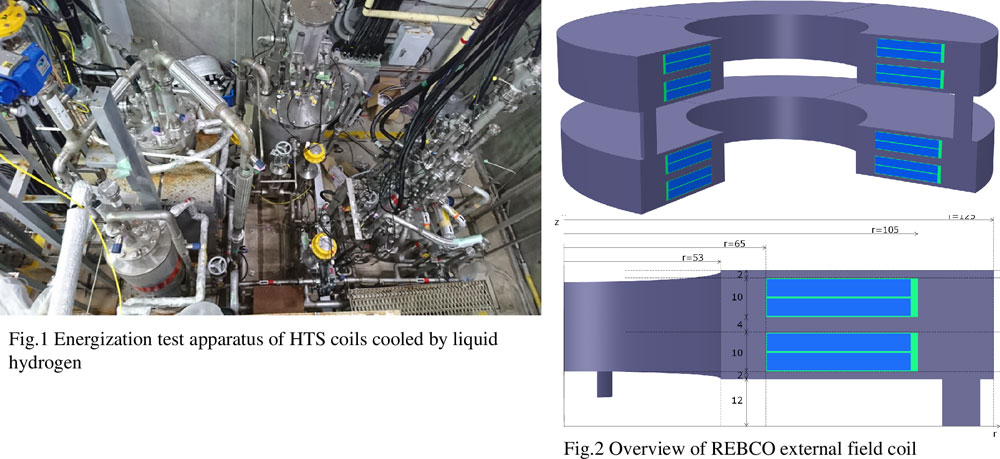AP-3-4
Energization test apparatus of HTS coils cooled by liquid hydrogen and manufacture of split-type REBCO external field coil
08:45-09:00 30/11/2023
*Masayoshi Ohya1, Shinsaku Imagawa2, Yasuyuki Shirai3, Hiroaki Kobayashi4
1. Kwansei Gakuin University, Hyogo, Japan
2. National Institute for Fusion Science, Gifu, Japan
3. Kyoto University, Kyoto, Japan
4. Japan Aerospace Exploration Agency, Kanagawa, Japan
Hydrogen power generation using imported liquid hydrogen (LH2) is being considered in Japan to achieve carbon neutrality by 2050 [1]. The economic challenge is the cost of liquefying hydrogen [2], which makes the effective use of the cold heat of LH2 essential. We have started to develop high-temperature superconducting (HTS) devices using LH2 as a coolant, in particular investigatin the advantages of immersion cooling. Studies have been carried out on the boiling heat transfer characteristics of LH2 [3] and the basic transport current characteristics of HTS wires [4]. The next step is to energize HTS coils under LH2 immersion cooling. The aim of the research is to establish a coil design that can continue to energize the HTS coil stably without thermal runaway by exploiting the high critical heat flux of LH2 even if local mechanical degradation occurs in the coil.
The energization test apparatus has been installed at the Noshiro Rocket Test Center of the Japan Aerospace Exploration Agency (JAXA). The inner diameter of the cryostat is 300 mm, the LH2 capacity is 50 L, the maximum pressure is 2 MPaG, and it has four 500 A current leads. A test coil is installed at the bottom of the cryostat insert, and energization tests can be performed on the coil directly cooled by LH2. The test facility has a 30 m2 liquid hydrogen tank. Liquid hydrogen is transferred once to a 50 liter storage tank and then to the cryostat. By adjusting the cryostat pressure and controlling the lower heater, the LH2 temperature can be controlled in the range of 20-32 K. The test site is equipped with two DC power supplies of ±5 V/400 A and ±10 V/200 A for superconducting coil excitation. During the test, a measurement system using optical LAN, PCL, and Labview software allows remote control, monitoring, and measurement.
A REBCO external field coil with an inner diameter of 106 mm and outer diameter of 250 mm was designed to carry out this research. The field coil was divided into upper and lower sections, with the test coil in the central space. By applying current in opposite directions to the upper and lower sections, a magnetic field perpendicular to the wire surface of the test coil can be generated. The field coil consisted of eight single pancake coils with 4 mm wide REBCO wires. Each double pancake coil was inserted into a stainless steel housing and firmly fixed together to withstand the repulsive electromagnetic forces. The manufactured field coil was cooled with LH2 and energized up to 150 A and verified to generate a magnetic field of 1.75 T as designed.No voltage rise was observed in any of the double pancake coils and there was no mechanical degradation due to electromagnetic forces. A test coil was then placed in the centre of the field coil and energized up to the region above the critical current, and it was verified that the test coil did not undergo thermal runaway even when a voltage of a few mV was generated.
[1] Y. Kanehana, “KHI’s activity for international liquefied hydrogen supply chain,” 2nd Hydrogen Energy Ministerial Meeting, 25 September 2019, Tokyo, Japan.
[2] "Current status of hydrogen liquefaction costs," DOE Hydrogen and Fuel Cells Program Record, no. 19001, 2019.
[3] Y. Shirai et al., “DNB heat flux on inner side of a vertical pipe in forced flow of liquid hydrogen and liquid nitrogen,” Cryogenics, vol. 92, 2018, pp. 105-117.
[4] H. Tatsumoto et al., “Development of a Thermal-hydraulics Experimental System for High Tc Superconductors Cooled by Liquid Hydrogen,” J. Phyasics: Conference Series, vol. 234, 2010, 032056.
This work is performed with the support and under the auspices of the NIFS Collaborative Research Program (NIFS20KOBA032).
